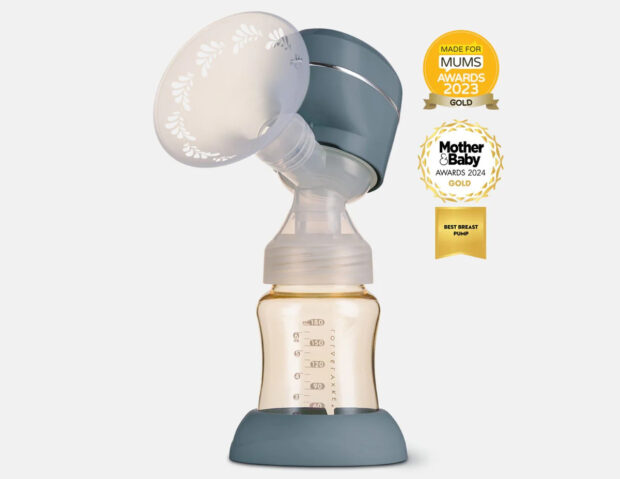How to Make Pumping More Comfortable and Efficient

How to Make Pumping More Comfortable and Efficient
For mums, pumping isn’t just about milk—it’s about reclaiming time, comfort, and peace of mind. With electric breast pumps, you’re not just pumping; you’re unlocking a world of efficiency and freedom that manual options can’t match, making pumping more comfortable. But no matter your choice, the right tips and techniques can make every pumping session smoother so you can focus on what matters most—your little one. Today’s blog will show you how to turn pumping into a moment of ease and empowerment.
1. Make your breasts comfortable during your pumping
Whether using an electric breast pump or pumping manually, prioritize your comfort first. Start with a hands-free nursing bra—your indispensable ally for multitasking. You can pump anywhere, anytime, without the hassle of holding bottles in place, making pumping from a chore to a seamless part of your day, especially during your working time.
When you start pumping, remember to find a position that works well for your body. Sit upright or recline slightly, ensuring you feel supported and relaxed. With manual pumping, you need to take extra care to avoid straining your wrists using ergonomic techniques or support cushions.
Don’t underestimate the benefits of touch in improving your pumping experience. Gentle breast massages before and during pumping can stimulate milk flow, making each session more productive. You can do it yourself or with your partner’s or your loved ones’ support!
2. Save efforts with powerful electric breast pumps
Not all electric breast pumps are created equal. While the convenience of an electric pump is undeniable, choosing the right one can make all the difference. A high-quality breast pump simplifies your pumping routine, saving time and energy while maximizing your milk output.
Look for models with customizable settings that allow you to adjust suction and speed to match your body’s unique rhythm. Sometimes, portable and rechargeable designs can make you feel better pumping on the go, whether at work, running errands, or simply enjoying a rare moment of quiet. However, don’t settle for a pump that exceeds your budget but doesn’t fit your needs—it’s a waste.
3. Get the right size for your pump parts
Noting powerful breast pumps is only half the battle—the real care lies in the details, particularly the size of your breast shields. An ill-fitting shield can lead to unnecessary discomfort, reduced milk flow, and even painful nipples, turning what should be a productive session into a frustrating experience. To avoid this, take the time to measure your breasts carefully, learn how to estimate the correct shield size, and choose a fit that meets your needs.

4. Master your pump settings like a pro
Here’s something you need to consider to perform the best pumping session:
- Clean all pump parts thoroughly before, during, and after each use.
- Follow the manufacturer’s instructions to prevent injury and extend the lifespan of your pump.
- Mimic your baby’s natural nursing pattern, starting with a high-frequency, low-suction setting. Then, switch to a lower frequency with higher suction to replicate slower, deeper gulps.
- Have an electric breast pump that suits your needs, whether it’s a personal-use pump (under 300 mmHg) or a hospital-grade pump (300–350 mmHg). While these categories differ in suction levels, some of the best breast pumps in the UK, like Lola&Lykke, can offer the best of both—starting with a gentle 141 mmHg and reaching a maximum of 321 mmHg.
5. Own a pumping routine that works well for yourself
Focus on frequency rather than duration, aiming for 10-15 minutes per session. You can pump during your daily activities—whether working, handling chores, or when your baby is asleep. Notably, many moms find that morning pumping is relatively better, as the milk supply tends to be higher.
Besides that, combination feeding can help balance your baby’s needs with your milk supply goals. This can work well for some mums, but not at all. That’s why you should tailor your pumping routine to fit your lifestyle and body without overwhelming your schedule.
6. Enjoy repetitive practices for a consistent milk flow
It’s time to prioritize your mental health. You can try to turn on soothing music, engage in meditation, have deep breathing, or sip warm milk to center yourself and keep your body relaxed. Don’t only do these practices when stressed out; incorporate them as part of your routine. Trust us: when your mind is at ease, your milk flow will follow suit—consistent, steady, and effortless.
7. Get ready for stress-free night-time pumping
Night-time pumping may not happen often, but it doesn’t have to be a hassle. Prepare your essentials ahead of time—keep everything you need within arm’s reach: your pump, bottles, cleaning supplies, and a cozy blanket. When you’re ready, it becomes your quiet time, not a chore. You can also ask your partner to stay with you, enjoy the calm, and make it a bonding moment.
8. Pump now, use the latter – Make the most of your milk supply
Pumping and storing milk can be a game-changer for busy days or times when you’re away from your baby. You should freeze extra milk in storage bags or bottles, keeping it in small portions for easy access when your baby needs it. Be strategic—pump just a few extra ounces every session, as expressed milk can become sour, spoiled, and harmful over time.
Our blog has just guided you through a practical and comfortable pumping experience. From manual pumping to using electric breast pumps, consider these tips to navigate your baby-feeding journey with ease and confidence. Don’t forget that choosing the right pump, building a healthy, proper pumping routine, and ensuring breast comfort are so important!
Guest Article.




